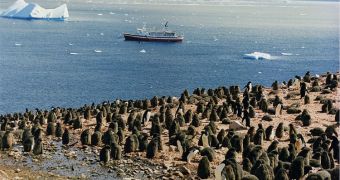Researchers at the American Museum of Natural History (AMNH), in New York City, led by Ross MacPhee, recently returned home from Antarctica with a cache of over 200 fossils belonging to marine reptiles, fish, birds, plants, and maybe even dinosaurs, possibly the largest such collection ever.
The team has been traveling to the Southern Continent for many years, but thus far their efforts haven't paid off. Instead, the researchers were blasted by hurricanes and snowstorm, while freezing in extremely low temperature.
But their persistence eventually paid off, and the research group managed to collect enough fossils to keep experts busy for a lifetime. “We did quite well,” MacPhee says, as quoted by the Antarctic Sun, referring to the new expedition the team conducted on a series of islands off the Antarctic Peninsula.
However, the research also had a downside, which is that the team did not recover any fossils belonging to Cretaceous mammals, which is what they were looking for in the first place. Finding such remnants would cover a lot of gaps in our understanding of mammalian evolution, the expert explains.
“All the biogeographical indications are that mammals had to have been there,” he adds. About 40 million years ago, Antarctica was still connected to South America and Australia, as part of the supercontinent called Gondwana.
This means that it was connected to regions where numerous fossils of varied origins were discovered. However, conducting studies in Antarctica is not as easy as trekking through the Australian outback or South American jungles.
MacPhee, a curator in the AMNH Mammalogy Department, says that he is mostly interested in Australian marsupials, which may have lived in what is now the Southern Continent after migrating from modern-day Australia.
Available data appear to suggest that this happened about 80 million years ago, long before the Cretaceous-Paleogene extinction event that killed the dinosaurs about 65 million years ago.
“It's surprising to me that we got no evidence this time because we were able to hit one area called Sandwich Bluff on Vega,” MacPhee says of a rock outcrop on one of the islands, which is known for harboring large amounts of Cretaceous fossils.
Mammalian remnants are “going to be rare because of the type of deposits we have to look in. We're not looking in conventional terrestrial-style basins,” the investigator concludes.

 14 DAY TRIAL //
14 DAY TRIAL //